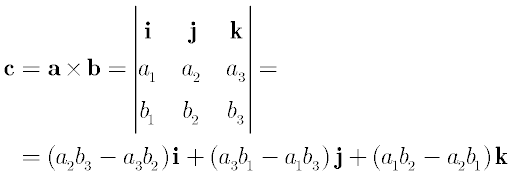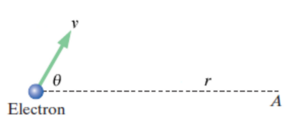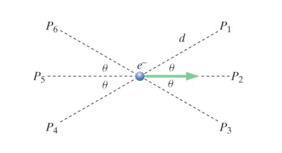Moving Point Charge: Difference between revisions
No edit summary |
|||
| (32 intermediate revisions by 6 users not shown) | |||
| Line 1: | Line 1: | ||
{{DISPLAYTITLE:Magnetic Field of a Moving Point Charge}} | {{DISPLAYTITLE:Magnetic Field of a Moving Point Charge}} | ||
(Grace Townsend Spring 2017) | |||
'''Blake Heard, Fall 2017''' | |||
==The Main Idea== | ==The Main Idea== | ||
[[File:B_Field.JPG|thumb|alt=moving point charge creates electric and magnetic field.|Magnetic field created by a moving charge. [http://www.webassign.net/ebooks/mi4/toc.html?page=23.3]]] | |||
As we have learned, a point charge creates an [[Electric Field]] that is given by Coulomb's Law: | |||
[[File:CoulombLaw.JPG]] | |||
However, when a point charge moves with some velocity, it not only creates an electric field, but it also creates a magnetic field that curls around the charge. | |||
===A Mathematical Model=== | ===A Mathematical Model=== | ||
The magnetic field of a moving point charge can be found using a derivation of the [[Biot-Savart Law]] for magnetic fields | The magnetic field of a moving point charge has units in Teslas (T) and can be found using a derivation of the [[Biot-Savart Law]] for magnetic fields: | ||
[[File: | [[File:BiotSavartv.gif]] | ||
where: | |||
<math> \frac{\mu_0}{4*\pi} = 1*10^{-7} \frac{T * m^2}{C * \frac{m}{s}} </math> | |||
In this equation, ''q'' represents the scalar charge of the particle, <math>\vec v </math> is the vector velocity of the moving particle, and <math> \hat r </math> is a unit vector that points from the charge to the observation location. <math>\vec v \times \hat r </math> is a cross product that can be computed by the formula: | |||
[[File:Crossprod.gif]] | |||
This cross product can also be expressed in terms of magnitude: <math> \left\vert \vec v \times \hat r \right\vert = \left\vert \vec v \right\vert \left\vert \hat r \right\vert \sin \theta </math> | |||
<math> \theta </math> in this formula represents the angle between <math>\vec v </math> and <math>\hat r </math> when they are placed tail to tail. | |||
[[ | The easiest way to determine the direction of <math>\vec v \times \hat r </math> is the [[Right Hand Rule]]. However, it is important to remember to take into account the charge of the particle from the Biot-Savart Law. If the particle is positively charged, the magnetic field will point in the same direction as <math>\vec v \times \hat r </math>, while the magnetic field will point in the opposite direction as <math>\vec v \times \hat r </math> if the particle is negatively charged. | ||
==A Computational Model== | |||
[ | VPython can easily model the magnetic field created by a moving charged particle. | ||
Check out this code: [https://trinket.io/glowscript/b44a832897 Magnetic Field for a Positively Charged Particle]. | |||
As the particle travels towards the observation location, it creates a magnetic field that grows in magnitude the closer the particle is to the observation location. As the proton gets farther away, the magnetic field decreases in magnitude as expected. | |||
Now compare with this code: [https://trinket.io/glowscript/13f8b6dd56 Magnetic Field for a Negatively Charged Particle]. | |||
This negatively charged particle is the exact same as the positively charged particle in all but its sign. Looking carefully reveals that this change in sign has reversed the direction of the magnetic field from what it was in the positively charged particle demo. | |||
==Examples== | ==Examples== | ||
===Simple=== | ===Simple=== | ||
At a particular instant, a proton at the origin has velocity < 4e4, -3e4, 0> m/s. Calculate the magnetic field at location < 0.03, 0.06, 0 > m, due to the moving proton. | At a particular instant, a proton at the origin has a velocity, <math> \vec v </math> of < 4e4, -3e4, 0 > m/s. Calculate the magnetic field at the observation location < 0.03, 0.06, 0 > m, due to the moving proton. | ||
'''Solution:''' | '''Solution:''' | ||
1. | ''1.'' First, find <math> \vec r </math> and <math> \hat r </math>. Subtracting the observation location from the source location gives us | ||
<math> \vec r = </math> < 0.03, 0.06, 0 >. | |||
The unit vector can then be found with the formula <math> \hat r = \frac{\vec r}{\left\vert \vec r \right\vert} </math>, which results in | |||
<math> \hat r = </math> < 0.447, 0.894, 0 >. | |||
2. Once we have both | ''2.'' Once we have both <math> \vec v </math> and <math> \hat r </math>, we can take their cross product and solve the Biot-Savart Law. The resulting cross product is < 0, 0, 49200 >. | ||
3. | ''3.'' Finally, we can finish solving the Biot-Savart Law by multiplying the charge of a proton, <math> 1.6*10^{-19} </math>, to our cross product from step 2 and dividing that by <math> \left\vert \vec r \right\vert^2 </math>. To finish, multiply by the constant: <math> \frac{\mu_0}{4*\pi} = 1*10^{-7} \frac{T * m^2}{C * \frac{m}{s}} </math> | ||
| Line 42: | Line 65: | ||
===Medium=== | ===Medium=== | ||
The electron in the figure below is traveling with a speed of | The electron in the figure below is traveling with a speed of | ||
<math> v = 4*10^6 </math>m/s. What is the magnitude of the magnetic field at location A if | <math> \left\vert \vec v \right\vert = 4*10^6 </math> m/s. What is the magnitude of the magnetic field at location A if <math> \left\vert \vec r \right\vert = 7*10^{-10} </math> m and <math> \theta = 57^\circ </math>? | ||
[[File:Example2vB.png|300x400px]] | [[File:Example2vB.png|300x400px]] | ||
| Line 48: | Line 71: | ||
'''Solution:''' | '''Solution:''' | ||
1. | ''1.'' Since we are given speed and the distance, <math> q\vec v \times \hat r = q\left\vert \vec v \right\vert\sin \theta </math>. | ||
2. | ''2.'' Now just plug into the Biot-Savart Law to find the final answer. | ||
<math> \left\vert \vec B \right\vert = 1*10^{-7}\frac{q\left\vert \vec v \right\vert\sin \theta}{\left\vert \vec r \right\vert^2} </math> | |||
The final answer will be approximately 0.11 T. | |||
===Complex=== | |||
An electron is moving horizontally to the right with speed <math> 6*10^6 </math> m/s. What is the magnetic field due to this moving electron at the indicated locations in the figure? Each location is d = 8 cm from the electron, and the angle θ = 33°. Give both magnitude and direction of the magnetic field at each location. | |||
=== | |||
An electron is moving horizontally to the right with speed <math> 6*10^6 </math> m/s. What is the magnetic field due to this moving electron at the indicated locations in the figure? Each location is d = 8 cm from the electron, and the angle θ = 33°. Give both magnitude and direction of the magnetic field at | |||
| Line 66: | Line 88: | ||
'''Solution:''' | '''Solution:''' | ||
1. | ''1.'' We are given the speed of an electron and its distance from other locations. Because of this, we can say: <math> q\vec v \times \hat r = q\left\vert \vec v \right\vert\sin \theta </math>. | ||
2. | ''2.'' Now plug into the Biot-Savart Law to find the magnitude of each magnetic field. | ||
<math> \left\vert \vec B \right\vert = 1*10^{-7}\frac{q\left\vert \vec v \right\vert\sin \theta}{\left\vert \vec r \right\vert^2} </math> | |||
''3.'' In order to find the direction of the magnetic fields, use the [[Right Hand Rule]]. | |||
Locations P2 and P5 will have a magnitude of 0 for their magnetic fields and therefore no direction. The direction of the magnetic fields of P1 and P6 are into the page, while the direction of the magnetic fields of P3 and P4 are out of the page. P1, P3, P4, and P6 all have a magnitude of <math> 8.17*10^{-18}</math> T. | |||
==Important Applications== | |||
A single moving point charge represents the most simple situation of charges moving in space to produce a magnetic field. In reality, this situation rarely occurs, however understanding how a single moving point charge interacts to produce a field will allow you to understand how sets of moving charges produce a field in space as well. | |||
We can use the magnetic field of a single moving charge formula to derive a more practical formula of a short current carrying wire: | |||
[[File:ILxR.png]] | |||
Where dl is a vector pointing in the same direction as the conventional [[current]] | |||
This formula is more applicable to many real life situations where we can have macroscopic objects that can be used to calculate the magnetic field, such as the [[Magnetic Field of a Long Straight Wire]] or a [[Magnetic Field of a Loop]]. | |||
We can apply the magnetic field formula to numerous situations by integration. | |||
==History== | ==History== | ||
[[Oliver Heaviside]] first derived | [[Oliver Heaviside]] first derived this relationship from Maxwell's Equations in 1888. The [[Biot-Savart Law]] was named after [[Jean-Baptiste Biot]] and [[Felix Savart]] who, in 1820, showed a needle deflection from a current carrying wire, thus relating electricity and magnetism. | ||
== See also == | == See also == | ||
| Line 95: | Line 125: | ||
http://maxwell.ucdavis.edu/~electro/magnetic_field/pointcharge.html | http://maxwell.ucdavis.edu/~electro/magnetic_field/pointcharge.html | ||
[[ | http://ruh.li/3DMathVectors.html | ||
[[Moving Point Charge]] | |||
Latest revision as of 23:27, 29 November 2017
(Grace Townsend Spring 2017)
Blake Heard, Fall 2017
The Main Idea
As we have learned, a point charge creates an Electric Field that is given by Coulomb's Law:
However, when a point charge moves with some velocity, it not only creates an electric field, but it also creates a magnetic field that curls around the charge.
A Mathematical Model
The magnetic field of a moving point charge has units in Teslas (T) and can be found using a derivation of the Biot-Savart Law for magnetic fields:
where: [math]\displaystyle{ \frac{\mu_0}{4*\pi} = 1*10^{-7} \frac{T * m^2}{C * \frac{m}{s}} }[/math]
In this equation, q represents the scalar charge of the particle, [math]\displaystyle{ \vec v }[/math] is the vector velocity of the moving particle, and [math]\displaystyle{ \hat r }[/math] is a unit vector that points from the charge to the observation location. [math]\displaystyle{ \vec v \times \hat r }[/math] is a cross product that can be computed by the formula:
This cross product can also be expressed in terms of magnitude: [math]\displaystyle{ \left\vert \vec v \times \hat r \right\vert = \left\vert \vec v \right\vert \left\vert \hat r \right\vert \sin \theta }[/math]
[math]\displaystyle{ \theta }[/math] in this formula represents the angle between [math]\displaystyle{ \vec v }[/math] and [math]\displaystyle{ \hat r }[/math] when they are placed tail to tail.
The easiest way to determine the direction of [math]\displaystyle{ \vec v \times \hat r }[/math] is the Right Hand Rule. However, it is important to remember to take into account the charge of the particle from the Biot-Savart Law. If the particle is positively charged, the magnetic field will point in the same direction as [math]\displaystyle{ \vec v \times \hat r }[/math], while the magnetic field will point in the opposite direction as [math]\displaystyle{ \vec v \times \hat r }[/math] if the particle is negatively charged.
A Computational Model
VPython can easily model the magnetic field created by a moving charged particle. Check out this code: Magnetic Field for a Positively Charged Particle. As the particle travels towards the observation location, it creates a magnetic field that grows in magnitude the closer the particle is to the observation location. As the proton gets farther away, the magnetic field decreases in magnitude as expected.
Now compare with this code: Magnetic Field for a Negatively Charged Particle. This negatively charged particle is the exact same as the positively charged particle in all but its sign. Looking carefully reveals that this change in sign has reversed the direction of the magnetic field from what it was in the positively charged particle demo.
Examples
Simple
At a particular instant, a proton at the origin has a velocity, [math]\displaystyle{ \vec v }[/math] of < 4e4, -3e4, 0 > m/s. Calculate the magnetic field at the observation location < 0.03, 0.06, 0 > m, due to the moving proton.
Solution:
1. First, find [math]\displaystyle{ \vec r }[/math] and [math]\displaystyle{ \hat r }[/math]. Subtracting the observation location from the source location gives us
[math]\displaystyle{ \vec r = }[/math] < 0.03, 0.06, 0 >.
The unit vector can then be found with the formula [math]\displaystyle{ \hat r = \frac{\vec r}{\left\vert \vec r \right\vert} }[/math], which results in
[math]\displaystyle{ \hat r = }[/math] < 0.447, 0.894, 0 >.
2. Once we have both [math]\displaystyle{ \vec v }[/math] and [math]\displaystyle{ \hat r }[/math], we can take their cross product and solve the Biot-Savart Law. The resulting cross product is < 0, 0, 49200 >.
3. Finally, we can finish solving the Biot-Savart Law by multiplying the charge of a proton, [math]\displaystyle{ 1.6*10^{-19} }[/math], to our cross product from step 2 and dividing that by [math]\displaystyle{ \left\vert \vec r \right\vert^2 }[/math]. To finish, multiply by the constant: [math]\displaystyle{ \frac{\mu_0}{4*\pi} = 1*10^{-7} \frac{T * m^2}{C * \frac{m}{s}} }[/math]
The final answer will be [math]\displaystyle{ \lt 0, 0, 1.75*10^{-19}\gt }[/math] T
Medium
The electron in the figure below is traveling with a speed of [math]\displaystyle{ \left\vert \vec v \right\vert = 4*10^6 }[/math] m/s. What is the magnitude of the magnetic field at location A if [math]\displaystyle{ \left\vert \vec r \right\vert = 7*10^{-10} }[/math] m and [math]\displaystyle{ \theta = 57^\circ }[/math]?
Solution:
1. Since we are given speed and the distance, [math]\displaystyle{ q\vec v \times \hat r = q\left\vert \vec v \right\vert\sin \theta }[/math].
2. Now just plug into the Biot-Savart Law to find the final answer.
[math]\displaystyle{ \left\vert \vec B \right\vert = 1*10^{-7}\frac{q\left\vert \vec v \right\vert\sin \theta}{\left\vert \vec r \right\vert^2} }[/math]
The final answer will be approximately 0.11 T.
Complex
An electron is moving horizontally to the right with speed [math]\displaystyle{ 6*10^6 }[/math] m/s. What is the magnetic field due to this moving electron at the indicated locations in the figure? Each location is d = 8 cm from the electron, and the angle θ = 33°. Give both magnitude and direction of the magnetic field at each location.
Solution:
1. We are given the speed of an electron and its distance from other locations. Because of this, we can say: [math]\displaystyle{ q\vec v \times \hat r = q\left\vert \vec v \right\vert\sin \theta }[/math].
2. Now plug into the Biot-Savart Law to find the magnitude of each magnetic field.
[math]\displaystyle{ \left\vert \vec B \right\vert = 1*10^{-7}\frac{q\left\vert \vec v \right\vert\sin \theta}{\left\vert \vec r \right\vert^2} }[/math]
3. In order to find the direction of the magnetic fields, use the Right Hand Rule.
Locations P2 and P5 will have a magnitude of 0 for their magnetic fields and therefore no direction. The direction of the magnetic fields of P1 and P6 are into the page, while the direction of the magnetic fields of P3 and P4 are out of the page. P1, P3, P4, and P6 all have a magnitude of [math]\displaystyle{ 8.17*10^{-18} }[/math] T.
Important Applications
A single moving point charge represents the most simple situation of charges moving in space to produce a magnetic field. In reality, this situation rarely occurs, however understanding how a single moving point charge interacts to produce a field will allow you to understand how sets of moving charges produce a field in space as well.
We can use the magnetic field of a single moving charge formula to derive a more practical formula of a short current carrying wire:
Where dl is a vector pointing in the same direction as the conventional current This formula is more applicable to many real life situations where we can have macroscopic objects that can be used to calculate the magnetic field, such as the Magnetic Field of a Long Straight Wire or a Magnetic Field of a Loop.
We can apply the magnetic field formula to numerous situations by integration.
History
Oliver Heaviside first derived this relationship from Maxwell's Equations in 1888. The Biot-Savart Law was named after Jean-Baptiste Biot and Felix Savart who, in 1820, showed a needle deflection from a current carrying wire, thus relating electricity and magnetism.
See also
References
http://maxwell.ucdavis.edu/~electro/magnetic_field/pointcharge.html




